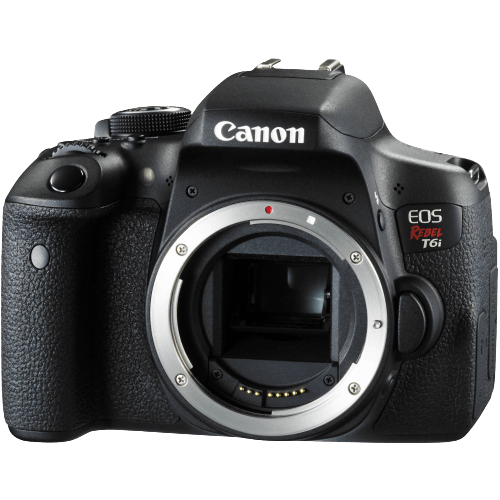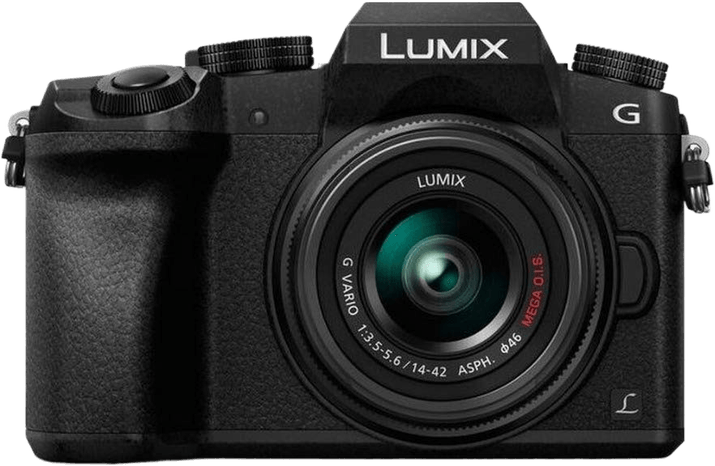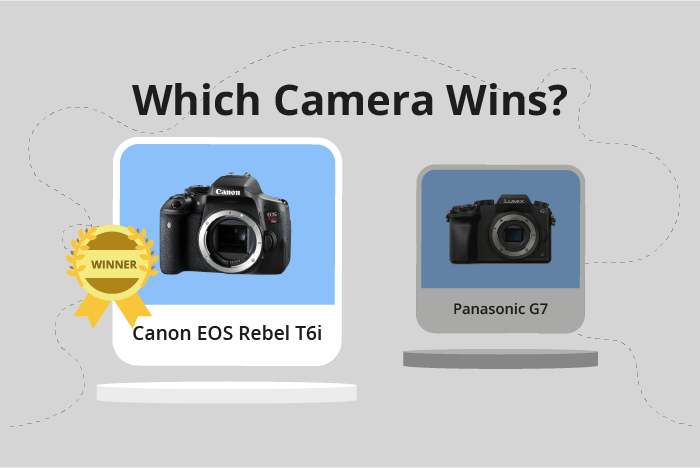Canon EOS Rebel T6i / 750D vs Panasonic Lumix DMC-G7 Comparison
Canon EOS Rebel T6i / 750D

Panasonic Lumix DMC-G7

The Canon EOS Rebel T6i (750D) outperforms the Panasonic Lumix DMC-G7 with a score of 56/100 compared to 52/100. Both cameras, released in 2015, share similarities such as DSLR and mirrorless camera types, announcement dates, and similar launch prices ($750 for the T6i and $799 for the G7).
The Canon T6i excels with its larger size (132 x 101 x 78mm) and heavier weight (555g / 1.22lbs), which may provide a more stable shooting experience. On the other hand, the Panasonic G7 offers a more compact and lightweight design (125 x 86 x 77mm and 410g / 0.90lbs), making it more portable and convenient for on-the-go photography.
Taking these factors into account, the Canon T6i provides a better overall performance, while the Panasonic G7 offers a more travel-friendly option.
Canon EOS Rebel T6i / 750D vs Panasonic Lumix DMC-G7 Overview and Optics
The Canon EOS Rebel T6i / 750D takes the lead in optics with a score of 59/100, compared to the Panasonic Lumix DMC-G7’s score of 51/100. Both cameras share common specifications, including a CMOS sensor type, the absence of image stabilization, and a shooting speed of 5 and 7 frames per second for the Canon T6i and Panasonic G7, respectively.
The Canon T6i outperforms the Panasonic G7 in several aspects. Firstly, it boasts a higher megapixel count of 24.2, allowing for more detailed images compared to the G7’s 16 megapixels. Additionally, the Canon T6i features a larger APS-C sensor, resulting in better low-light performance and improved image quality. The camera also uses the Digic 6 processor, contributing to faster and more efficient image processing.
On the other hand, the Panasonic G7 has its own advantages. It has a higher DXOMARK score for the sensor at 75, promising better color depth and dynamic range. The G7 also offers a faster shooting speed of 7 frames per second, making it more suitable for action photography. Moreover, the camera uses a Micro Four Thirds lens mount, providing a wider range of lens options.
In comparing these cameras, the Canon T6i emerges as the better option for photographers prioritizing image quality and detail, as well as low-light performance. However, the Panasonic G7 caters to those who value a faster shooting speed and a broader lens selection. Ultimately, choosing between these cameras depends on individual preferences and photography needs.
Canon EOS Rebel T6i / 750D vs Panasonic Lumix DMC-G7 Video Performance
The Panasonic Lumix DMC-G7 outperforms the Canon EOS Rebel T6i / 750D in video capabilities with a score of 83/100 compared to the Canon’s 43/100. Both cameras share some common specifications, such as Full HD video resolution and a maximum video dimension of 1920 x 1080. However, the G7 excels in several aspects, making it the superior choice for video recording.
The G7 offers 4K video resolution, which is four times the resolution of the T6i’s Full HD. This higher resolution results in more detailed and sharper videos. Additionally, the G7 has a maximum video frame rate of 60fps, allowing for smoother footage and better slow-motion effects compared to the T6i’s 30fps. The G7 also includes built-in time-lapse functionality, providing more creative options for videographers.
The T6i does not have any notable advantages in video capabilities over the G7. Its lower score reflects its limited features compared to the more advanced G7. Although both cameras can record Full HD videos, the G7’s additional features make it a better option for those prioritizing video quality.
Considering the significant difference in scores and the G7’s superior specifications, it is clear that the Panasonic Lumix DMC-G7 is the better choice for video recording. With 4K resolution, a higher frame rate, and built-in time-lapse functionality, the G7 offers more advanced video capabilities than the Canon EOS Rebel T6i / 750D.
Canon EOS Rebel T6i / 750D vs Panasonic Lumix DMC-G7 Features and Benefits
The Panasonic Lumix DMC-G7 emerges as the winner in this comparison, with a feature score of 58/100, slightly ahead of the Canon EOS Rebel T6i / 750D’s score of 57/100. Both cameras share several features, including a 3-inch screen size, touchscreen capabilities, flip screen, absence of GPS, WIFI connectivity, and lack of Bluetooth.
The Lumix DMC-G7 takes the lead with its superior screen resolution of 2,360,000 dots, which is more than double the 1,040,000 dots of the Rebel T6i / 750D. This higher resolution provides a sharper and more detailed display, making it easier for users to review their shots and navigate the camera’s settings.
The Canon EOS Rebel T6i / 750D, despite having a lower feature score, still offers comparable features to the Lumix DMC-G7. Both cameras provide the convenience of a touchscreen and flip screen, allowing users to take photos and videos from various angles easily. Additionally, they both have WIFI connectivity, enabling users to transfer files wirelessly and control the camera remotely.
While the Lumix DMC-G7’s higher screen resolution gives it an edge over the Rebel T6i / 750D, both cameras have a solid set of features that cater to different users’ needs. The choice between the two ultimately depends on individual preferences and priorities in terms of screen resolution and other camera specifications.
Canon EOS Rebel T6i / 750D vs Panasonic Lumix DMC-G7 Storage and Battery
The Panasonic Lumix DMC-G7 wins the storage and battery comparison with a score of 35/100, while the Canon EOS Rebel T6i / 750D scores 24/100. Both cameras share similarities in storage, having a single memory card slot and accepting SD, SDHC, and SDXC cards. However, the G7’s cards are not UHS-I compatible like the T6i’s.
The T6i prevails in battery life, providing 440 shots compared to the G7’s 350 shots. The T6i uses an LP-E17 battery, while the G7 uses a DMW-BLC12E battery. Conversely, the G7 outshines the T6i with its USB charging capability, a feature absent in the T6i.
To sum it up, the G7 is superior in storage and battery aspects due to its higher score and USB charging feature, while the T6i has a longer battery life.
Alternatives to the Canon EOS Rebel T6i / 750D and Panasonic Lumix DMC-G7
Are you still undecided about which camera is right for you? Have a look at these popular comparisons that feature the Canon EOS Rebel T6i / 750D or the Panasonic Lumix DMC-G7:

